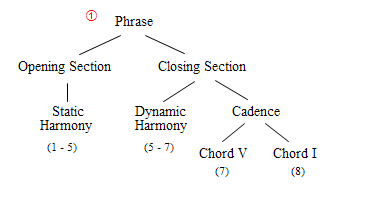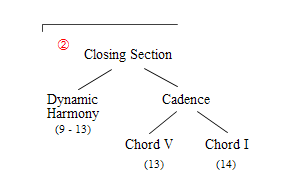CHAPTER 8 - EXAMPLE MUSICAL ANALYSES
SCHUMANN - KINDERSZENEN NO. 1
Step 4 - Identify the Musical Phrase Structures
Now that we have established the underlying root progression patterns and identified how these create episodes of static harmony and dynamic harmony, we can see how these episodes combine to form musical phrase structures. This example also shows how these complete and an incomplete phrase structures combine to form larger syntactic structures that relates to the formal structure of the movement. For a summary of the main variations of the basic syntactic structure and how they are used see Chapter 6: Extensions to the Basic Structure.
Phrase 1 (bars 1 to 8).
We can see from the preceding voice leading and root progression analyses and from the analytical outline, that this phrase starts with a 5 bar segment of static harmony, (I - V - I - V - I) prolonging the tonic G chord. This is followed by dynamic harmony (one alpha (α) progression followed by a gamma (γ) progression) from bar 5 to bar 7. This phrase ends with a "full close" or perfect cadence: V - I, so that this phrase forms a complete musical phrase structure. As indicated in the syntax diagram, below, and in the analytical outline, it contains: the opening section static harmony , the closing section dynamic harmony and a V - I cadence.
The phrase is thus represented in the analytical outline by the standard syntactic structure diagram, as follows:

The numbers in brackets indicate bar numbers. The number 1 in a circle, in the piano reduction and analysis outline, indicates that this is phrase 1. This is a complete phrase structure and forms the whole of section A of the formal structure. It is not conjoined with any other phrase.
Phrase 2 (bars 9 to 14)
As previously indicated, unlike phrase 1, this phrase is incomplete as it contains only dynamic harmony and a cadence. Because it is incomplete it conjoins with the next phrase to form a larger complete unit, as confirmed by the formal analysis. This phrase is represented by the syntax diagram as follows:

The beam above phrase 2 indicates that it is conjoined to phrase 3. This is consistent with the overall formal structure of the piece as this phrase and the third phrase combined make up the second repeated section of the movement, as indicated in the Formal Analysis. As is often the case in tonal pieces, this phrase acts as a dynamic lead-in to the final full syntactic structure.
Phrase 3 (bars 15 to 22)
This phrase is the final phrase of the movement and, as is usual with final phrases, it is a complete phrase. It is in fact, an exact repeat (apart from the minims in the final bar) of the first phrase. This phrase conjoins with the second phrase to make a larger complete unit which forms the second part of the formal structure. For more on conjoining see Chapter 6: Extensions to the Basic Structure.
The phrase is thus represented in the analytical outline by the standard syntactic structure diagram, as follows:

The horizontal bracket above the diagram indicates that this phrase is conjoined with the previous phrase which is incomplete.
The overall structure of the movement is thus: one complete phrase, an incomplete phrase which is the middle section of the structure which conjoins with a final phrase which is a repeat of the first complete phrase.
Summary
The preceding analyses show how the surface voice leading patterns combine to form motivic structures which in turn form melodies. Once the voice leading surface is accounted for, the underlying root progression patterns are revealed and these follow familiar patterns for tonal music. The root progression patterns are segmented into alternating segments of static harmony and dynamic harmony. Examples of static harmony made up of prolongations of chord I (using chord V as the auxiliary chord) are included in this analysis. Dynamic harmony is composed of a series of chord progressions. All the root progressions in the dynamic harmony episodes in this piece are: rising 4th (α) or falling 3rd (β) or rising 2nd (γ) progressions. These are the three most common root progressions in dynamic harmony in tonal music. The choice of auxiliary chords in static harmony and the choice of root progression in dynamic harmony and the choice of cadence all contribute to the style and mood of the music as indicated in the detailed analysis.
This analysis also shows how segments of static and dynamic harmony form the fundamental building blocks of the phrase structure of tonal music. In addition, this example shows one of the most common ways that incomplete and complete structures can be conjoined to form larger structures.
This demonstrates how the three syntaxes (voice leading, root progressions and phrase structure) work together to create content and structure in tonal music. Similar, but slightly different patterns can also be observed in music that is influenced by modal scales and harmonies. The differences are indicators of the style of the music.
This has some similarities to the way that the three main syntaxes in language work together: phonetics that governs the structure of sounds; morphology that governs the structure of words; syntax which governs the structure of sentences. For more on this, see the section Connection with Linguistics.
This forms a much richer analysis of the music than by other methods and brings together a combination of elements of musical analysis: formal, motivic, thematic, voice leading, root progression and phrase syntax. The method is also sensitive to the style of the music. The method does not involve reducing the music to any predetermined pattern but rather brings out the structure in the piece itself.

